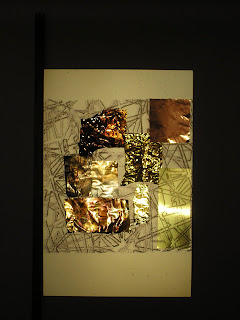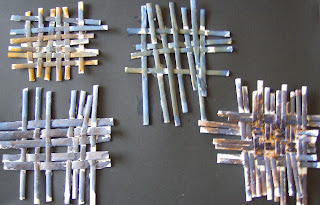

After seeing all my bits and pieces for the assessment piece, Sian gave me some more ideas for backgrounds, one of which was to try plain white panels set at angles. I like this idea - it can look interesting by itself while not being too busy when the projection is going. Here are some photos of my trials using artist's stretched box canvases - the mysterious dark shape at the right is a metre rule to show the scale. I haven't worried too much about placing the canvases other than trying to echo the lines/shapes that will appear - the arrangement would need to fit the space where it is being shown and the size of the projection may vary. I was hoping to get some strong shadows as well but may have to wait until the summer - it is cloudy and wet this week and we have had virtually no daylight in the house. The three pictures below show stages of the animation - the odd colour is because the canvases are bright white but the wall is slightly peachy. My husband has been very understanding about the blu-tac marks on the wall but I think he would draw the line at repainting it white just for a photo.
Picture quality isn't brilliant - it is a case of juggling focus on the projector and the camera and not getting in front of the light. It is quite interesting to see the slide projection close-up on the canvases as the greys split into different coloured pixels. One rainy Sunday, I should try copying the design in paints onto a spare canvas.
















 .
. .
. .
.












